

| WHICH WAS THE WORLD'S FIRST GENUINE 100 MPH STEAM LOCOMOTIVE ? | ||
 | This page re-formatted and reloaded to the internet on 7 March 2021 |  |
| Index Help needed to complete the missing loco technical details for locos shown as "Nearly Complete" below. | ||
| The first time a steam loco reached 100 mph | ||
| Introduction | Updated 20th April 2005 | |
| New York Central 4-4-0 No 999 | 1893 | Complete |
| GWR 4-4-0 No. 3440, City of Truro | 9th May 1904 | Nearly Complete |
| Philadelphia & Reading RR P5 Atlantic No. 343 | 14 June 1907 | Nearly Complete |
| Bavarian 4-4-4 No. 3201 | 2 July 1907 | Nearly Complete |
| Pennsylvania E6 s 4-4-2 No. 460 | 11 June 1927 | Nearly Complete |
| Milwaukee F6 Hudson No. 6402 | 20 July 1934 | Nearly Complete Updated 18th April 2005 |
| LNER A3, (A1), No. 4472, Flying Scotsman | 30 Nov 1934 | Nearly Complete Updated 19th April 2005 |
| LNER A3 4-6-2 No. 2750 | 5 March 1935 | Nearly Complete Updated 20th April 2005 |
| Conclusion | Complete Updated 20th April 2005 | |
| The first time a steam loco reached 100 mph in the 21st Century | ||
| DR 18 201 | 5 May 2002 | Nearly complete Updated 9th May 2005 |
| CREDITS for help | Basis of help given | |
| Introduction |
|
This web page shows the results of considerable research into one of the most controversial areas of steam loco performance: which was the first to an authenticated 100 mph! My research has covered Europe and North America in detail. From both those parts of the world came a significant number of claims for steam locos considered to have been the first to have reached the magic three figures. Some claims widely inaccurate and not considered here. And one wildy inaccurate claim that is covered here as the loco, NYC #999 was subsequently preserved in a Museum on the basis of it's exploits!
One key point has emerged. Little if no detailed timing data remains for some undoubted fast runs. Which is a great pity as the magic 100 could have been reached before the dates shown in my conclusions. Indeed in some cases, such as the incredibly fast "Lindbergh Run", the only times are those from the railroad company's dispatchers. Thankfully for some runs certain details have been published, and most contenders that I have come across within the UK do have full documentation still available. For the simple reason the UK is the home of train timing, having started in the 1880's and continued to the present day. I am very mindful in publishing the results of my research that my train timing peers will look closely at my reasoning and the evidence I base my conclusions on! I have also kept away from the emotion that surrounds certain of the 100 mph claims. That is an area where supporters of particular locos, who in most cases have never undertaken or understood the mechanics of train timing, cling to beliefs that their loco must surely have been the first to 100 mph because it has been published, (erroneously), as such and the loco has been preserved for that exploit. I have come across at least four such preserved locos in my research, two of them in the UK! Many people have helped me in my research and I have named some, but I am sure I have missed other helpers for which I apologise. That help came from various on-line appeals. Indeed I leave open the route for anyone who comes across timing records of very high speed steam operation to please contact me. Research such as this can never really end and I will always consider any circumstances that warrant changes being made. In addition I do need help with the missing technical details for certain locos included within this web page. |
| Bryan Benn, Kent, England, Spring 2005
|
| New York Central & Hudson River 4-4-0 No. 999 |
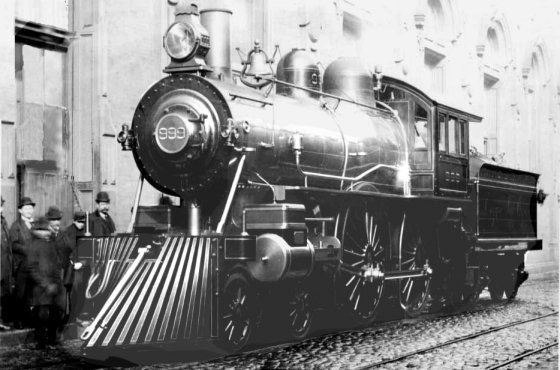
New York Central & Hudson River 4-4-0 No. 999. Photo: Dick Bolt web site |
| New York Central & CH 4-4-0 No. 999, as built and used in May 1893, before later rebuilding | ||||
| Built | 1893 | Total weight loco and tender | 93.3 imp. tons | |
| Number Built | One | Fuel | Coal | |
| Withdrawn | Circa 1930s, now preserved | Fire grate area | 30.7 sq ft | |
| Cylinders | 2, 19" x 24" | Max i.hp | circa 1000 | |
| Driving Wheels | 86" diameter | Boiler Pressure | 190 psi | |
|
Background NYC #999 is one of the world's most famous steam locos. Built in 1893 for New York Central's "Manhattan-Albany-Buffalo Empire State Express" it was one of 62 locos at Chicago's Columbian Exposition. It's claim to fame and the reason it has been preserved, (Chicago Science & Transportation Museum), was because of a May 1893 run between Rochester and Buffalo, NY. On that run it is said to have become the fastest machine of it's time, reaching 112.5 mph between Batavia and Corfu. What are the facts concerning this high speed journey? It is over a 100 years since this run, and no detailed timing details have been found. However such details must have been made as a 1976 article by John F Clay states there were 2 experienced observers on board. The practice of taking detailed passing times to the nearest second and stopwatching between quarter mile posts had started around a decade earlier, and formed the basis of accurate train timing that has survived from the late 19th Century, through the 20th Century and into the 21st Century. But back in May 1893 there was another group of "train timers" travelling behind No. 999. Railway Officials and Newspaper Reporters. Not two groups of people who are likely to have studied or understood the mechanics of putting together a very detailed and accurate log of a train journey, including recording it's maximum speed. It must certainly have been this group of people, probably taking random times without any other detailed substantiation, who recorded the 112.5 mph. It certainly wasn't the two experienced train timers who recorded such a high maximum speed. They recorded a maximum of 81.5 mph, which is almost certainly very close to what was reached that day. It is reported that some time later the high speed attempt was repeated to prove it was possible, and the maximum speed recorded on this second run was again near to 81 mph. Did NYC 4-4-0 No. 999 reach or exceed 100 mph? The reality of that day in May 1893 was that the 4-4-0 went no faster than around 82 mph. No expert on steam locomotive performance recording has ever given any credence to a higher maximum speed. Only massive errors by people on the day who may well have had no experience at all of proper train timing, (or speed timing of any type), lead to the over 100 mph claim being made. And those people included newspaper reporters, so the highly inaccurate speed would have been given immediate widespread publicity, creating the "legend", and eventually leading to the preservation of NYC No. 999. Credits Thanks to Alan Rees, Paul Berry, Dick Bolt, Steve Llanso, Kurt Müller, Steve Palmano, Reg Stocking and Roger Wines help with this "#999" page |
| Great Western Railway City Class 4-4-0 No. 3440 |
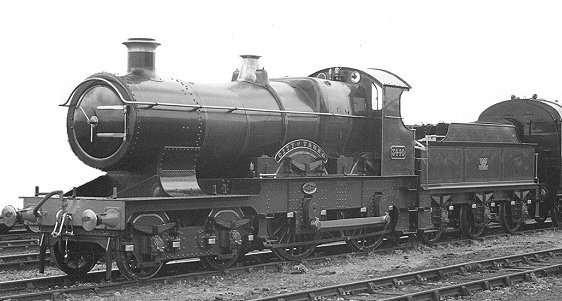
Great Western Railway 4-4-0 No. 3440, (originally No. 3717), "City of Truro". From a colour photo by Brian Proctor on his Aeroweb Space Site |
| The Great Western Railway City Class 4-4-0s | ||||
| Built | Swindon Shops 1903 & 1907-8, (rebuilt Atbara class) | Total weight loco and tender | 90 tons | |
| Number Built | 20 locos No.s 3700-3719 | Fuel | Coal | |
| Withdrawn | All by 1931, with 3440 preserved | Fire grate area | 20.56 sq ft | |
| Cylinders | 2, Size to follow | Max i.hp | 1000 | |
| Driving Wheels | 80.5" diameter | Boiler Pressure | 200 psi | |
|
Background GWR 4-4-0 "City of Truro" is perhaps at the centre of the longest running controvery surrounding the performance of any steam railway locomotive. That debate originates from 9th May 1904 when "City of Truro", with driver Clements at the controls, hauled the mail from a Transatlantic Steamer over the 128.1 miles from Millbay Crossing, Plymouth, to Pylle Hill Junction, Bristol, in 123 minutes and 19 seconds. The run was timed by Charles Rous-Marten and on the descent from Whiteball to Wellington he claimed to have recorded a maximum speed of 102.3 mph immediately before a sharp brake application was made. This was because it is said there were platelayers on the track ahead who were slow to move to one side. As a result of this claim to have become the first steam locomotive in the world to have reached 100 mph "City Of Truro" has been preserved. What are the facts concerning this high speed journey? Timing details are available for this run and those have long been the subject of endless debate by interested parties. Also subject of much debate has been the manner in which Rous-Marten recorded the times, and whether he was a reliable and accurate timer. Cecil J Allen once went on record commenting that Rous-Martens figures for this run were "few and contradictory" and also questioned whether a milepost had been misread. Perhaps even more importantly C J Allen also goes on to question whether Rous-Marten's known fiery temperament would have upset his timing accuracy. The critical part of this run is the steep climb to the summit at Whiteball where Rous-Marten claimed the train was doing 62 mph, followed by an astonishing acceleration down the average 1/96 grade, ( max 1/80, easiest 1/127), towards Wellington that culminated in the claimed 102.3 mph under 3½ miles from the summit, before the brakes were applied reducing the speed to around 80 mph. Over such a relatively short distance where a high speed was certainly reached followed by a sharp braking, debates on what maximum speed could have been reached would be endless, as indeed they have been! I do not propose to cover those debates here, as there is a much simpler way of determing the most likely maximum speed achieved by "City of Truro" on 9th May 1904. By reference to the required horespower. | ||||
|
The horesepower argument City of Truro was a saturated, (non superheated), steam loco with a maximum indicated horsepower similar to other contemporary 4-4-0s: approaching 1000 ihp. That maximum is known to be in the lower speed ranges, (less than 50 mph), for this 4-4-0. As a steam loco speed increases past it's peak power output, the max indicated horsepower falls. For "City of Truro" to around 700 ihp at 90 mph, falling more at higher speeds. With a speed of 62 mph at Whiteball the average indicated horespower to accelerate the 118 ton train to over 100 mph in less than three and a half miles would be around 1400 ihp, so far above the absolute maximum of City of Truro, (and contemporary saturated 2 cylinder 4-4-0s), as to end the debate immediately! With the quoted 148 ton train weight the required horsepower rises even more above that impossible 1400 ihp level, and rises yet again if the starting speed of 62 mph is not believed, and was the 52 mph that CJ Allen, O S Nock and others viewed as the maximum supported by the times. To continue accelerating through the 100 mph mark on the basis claimed by Rous-Marten would have need a final ihp of near 3000! But in the real world, detailed, sensible calculations show that City of Truro with a 118 ton train could have developed sufficient horsepower to have just got into the low 90s, maybe a 92 mph maximum. With a 148 ton train the maximum may not even have reached 90 mph. "City of Truro" would have needed to have produced a level of horsepower so far above it's maximum possible output as to make any consideration of significantly higher speeds totally unrealistic. Determining the maximum likely speed achieved by "City of Truro" by horsepower calculations uses a totally factual approach, where the only conclusions I have ever seen from serious and established students of loco perfomance is that "City of Truro" did not reach 100 mph. Contrary to that is what I call the "emotional approach". An approach followed by many supporters of the claimed 102.3 mph maximum, who look at the claimed maximum speed as what they would like to have seen achieved, not what was actually achieved, or was even remotely possible. Maybe Rous-Marten took the same approach. Did GWR "City of Truro" 4-4-0 No. 3440 reach or exceed 100 mph? "City of Truro's" likely maximum hauling a 118 ton train was 92 mph. 90 mph if the train weighed 148 tons. "City of Truro" is therefore no different from NYC #999 and other USA steam locos preserved because of highly inaccurate speed claims. Claims that have at least ensured "City of Truro" and the USA locos were saved from the cutter's torch. Allowing them to remain as fine reminders of early 20th century steam locomotive technology, all with their groups of enthusiastic supporters still "shouting the odds" over their own loco's supposed achievements. With those who support "City of Truro" perhaps the most vociferous. Credits I have drawn on what many have said & published, including Doug Landau, (ihp. calculations), Steve Palmano & David Veltom | ||||
|
Philadelphia & Reading Railroad P5 "Camelback" Atlantic No. 343 |
 Philadelphia & Reading "Camelback" P5 Atlantic #342, (similar to No. 343), in 1907. Photo thanks to the North East Rails web site
Philadelphia & Reading "Camelback" P5 Atlantic #342, (similar to No. 343), in 1907. Photo thanks to the North East Rails web site
|
| The Philadelphia & Reading P5 Atlantics | ||||
| Built | Reading Shops in 1907 | Total weight EXCL tender | 84.8 imp. tons | |
| Number Built | 10 locos nos 340 to 349 | Fuel | Anthracite, (2 firemen) | |
| Withdrawn, (all scrapped) | To Follow | Fire grate area | 94.5 sq feet | |
| Cylinders | 2 sized 22" x 26" | Max i.hp | To follow | |
| Driving Wheels | 86" diameter | Boiler Pressure | 235 psi | |
|
Loco type, "Camelback" This steam loco type was a product of the anthracite coal carrying railways of Pennsylvania that burned the product they hauled, a cheap and abundant fuel. John E. Wootten who became the Motive Power Chief of the P & RR developed a boiler that could burn this fuel, which was a waste product known as culm, arising from the screening of anthracite for home use. To burn well culm needed a widened fire grate about twice the size of those in use at the time without increasing the distance the fireman had to throw the coal. To fit, it had to be located above the driving wheels, therefore obstructed the driver's view. |
| Because the wide fire grate obstructed the driver's view he was moved forward to a cab astride of the boiler; the fireman staying at the rear. This loco type became known as a "Camelback" or "centercab". Because of safety concerns about the exposed fireman and the location of the driver right over the coupling rods, further construction of Camelbacks was banned from 1918. |
|
Background
The Philadelphia & Reading RR route from Camden to Atlantic City was 55½ miles and in competition with another route. This lead to fast 50 minute schedules in the early 20th century, and locos designed to keep them. The fast running attracted British train timers and in May 1905 Sir William Ackroyd recorded 42 minutes 33 seconds for the distance behind a slightly smaller P4 Camelback: a 78.3 mph average later considered a world record for some time by C J Allen. An earlier 46 minute run timed by Norman McDonald had seen 35 miles covered at an 83 mph average. That indicates Sir William Ackroyd's much quicker run could easily have seen speeds well into the 90s. Years later in 1926 Baron Gerard Vuillet visited the head offices of the P & R RR and found other fast run details, including one on 14th June 1907 where P5 No. 343 had run the distance in 41 minutes exactly, covering one mile in 36 seconds; an average speed of 100 mph. |
|
What are the facts concerning this high speed journey?
John F Clay's 1976 "Railway World" article gave more details of the14th June run. It shows No. 343 was hauling 260 tons, did the run in 41 minutes, (81.2 mph ave), with driver M J Rattigan and the "mile in 36 seconds" is amplified as being down a 1/167 grade. But no other details, and it is not known if this run was timed by a British observer, or recorded more casually. Both Baron Vuillet and John F Clay expressed the view that these locos were capable of 100 mph and the loco's "vital statistics" in the table tend to confirm that. But that does not prove the specific 100 mph claim on 14th June 1907. If the time was faster than Sir William's 42 mins 33 second epic then certainly some very high speeds indeed must have been reached to achieve what could have been steam's first 80 mph start to stop run. But I'll doubt we will ever find out the true maximum. |
|
Did Philadelphia & Reading Railroad P5 "Camelback" Atlantic No. 343 reach 100 mph?
P & R RR No. 343 could well have reached 100 mph on that down grade on June 14th 1907 during an extremely fast journey. However, without the backing of sufficient documentation it cannot claim to have been the world's first authentic 100 mph steam loco. But it is the first serious contender for the title that has emerged so far. |
| Credits Thanks to the steam locomotive.com web site for the background on these locos.
|
| Bayerisches S2/6 No. 3201 |
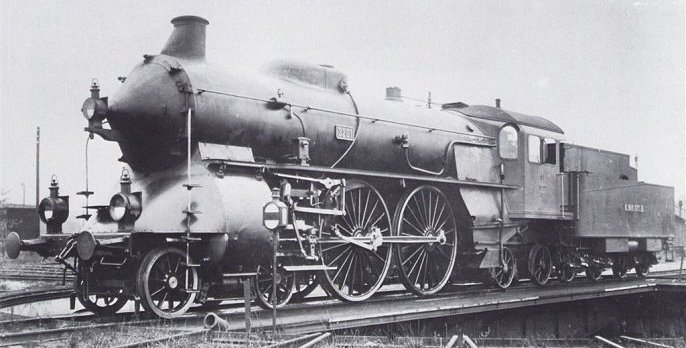
Bayerisches S2/6 No. 3201. Photo from the Helmut Dahlhaus Collection |
| Bayerisches Compound 4-4-4 S2/6 Number 3201 | ||||
| Built | Maffei 1906 | Total weight EXCL tender | 84 tons | |
| Number Built | 1 loco No 3201 | Fuel | Coal | |
| Withdrawn | Around 1925, now preserved | Fire grate area | 50.6 sq feet | |
| Cylinders | 4, (HP) 16.2"x25.2", (LP) 24"x25.2" | Max i.hp | To follow | |
| Driving Wheels | 86.6" diameter | Boiler Pressure | 200 psi | |
|
Background Bayerisches S2/6 No. 3201 4-4-4 was a "once off" type of team locomotive designed to haul relatively light passenger trains on schedules that were, for the early 20th Century very fast. It is a four cylinder compound steam locomotive, the first of such a design to feature on this particular web page. By using the exhaust steam from the high pressure cylinders to operate two further low pressure cylinders this type of loco had a significant power advantage over similar sized "simple" designs. What are the facts concerning this high speed journey? The most important fact is that on 2nd July 1907 No. 3201 did not reach 100 mph! But in the progression from the early unsupported claims shown above for the first steam locomotive to have reached 100 mph, No. 3201 set a new highest authenticated speed for steam traction. That is why, with a speed of between 96 mph and 97.6 mph this locomotive earns it's place here. The circumstances were a test run on 2nd July 1907 between München and Augsburg which in part was to test the builders claim that the loco was capable of 150 km/h, (93 mph). The exact recording method has not been identified yet, but for the present it is assumed that as this was a special test run proper arrangements were in place: if not there was little purpose in undertaking the test! It is said the maximum speed was reached on level track, but having timed steam over that route in 2002, (at up to 91 mph), I know the route to be quite undulating in places so the level track maximum may well have had the prior assistance of a downhill grade. There is a little doubt as to the exact maximum speed as German sources normally quote 96 mph, (154.5 km/h), whereas Baron Gerard Vuillet mentions it as 97.6 mph, (157 km/h). Whichever of those is correct does not detract from the fact that on July 2nd 1907 No. 3201 is likely to have set the fastest authentic speed by a steam loco up to that time. Did Bayerisches S2/6 reach 100 mph? No, it didn't. But by reaching between 96 mph and 97.6 mph on what is believed to be a properly measured test run the four cylinder compound 4-4-4 set a new world's fastest speed for steam traction. Credits Thanks to Helmut Dahlhaus and Konrad Koschinski, (Author of Eisenbahn Journal "Rekordloks"), for help with this 3201 page. |
| Pennsylvania Rail Road E6s 4-4-2 No. 460 |
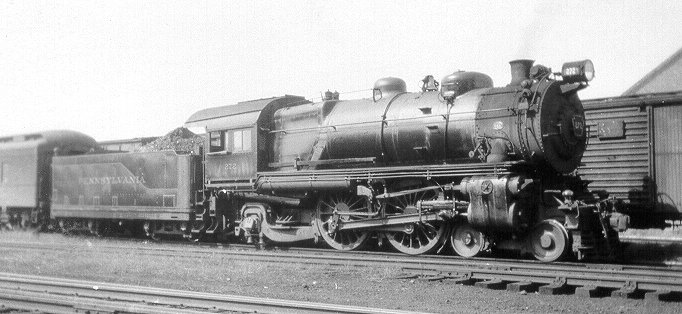
Pennsylvania RR E6 s No. 272, (similar to No. 460 ). Photo thanks to the Don Ross Collection |
| Pennsylvania 4-4-2 E6 s class | ||||
| Built | Juniata 1914 | Total weight EXCL tender | 110.5 imp. tons | |
| Number Built | To Follow | Fuel | Coal | |
| Withdrawn | To Follow, 460 preserved | Fire grate area | 55.2 sq feet | |
| Cylinders | 2, 23.5" x 26" | Max i.hp | 2520 | |
| Driving Wheels | 80.0" diameter | Boiler Pressure | 205 psi | |
Background The Pennsylvania E6s, (superheated), Atlantics were very powerful steam locos, sometimes called a "product of the test bed" by English mechanical engineers because of the amount of test work done on the class. The peak indicated horsepower recorded on test for one of these locos was 2,520. A very high figure indeed for a steam loco built fairly early in the 20th Century. What are the facts concerning this high speed journey? On 11th June 1927 Charles Linbergh returned to the US after his momentous flight across the Atlantic. He returned to his homeland on board the U.S.Navy cruiser "Memphis" which moored up on the banks of the Potomac River at Washington to let "Lindy" receive a heros welcomed. Meanwhile, on track 8 of Washington Union Station Pennsylvania E6s Atlantic No.460 on a two coach train waited for the Newsreels of Linbergh's triumphant return. The short train had been chartered by the International News Reel Company to take the newsreels to New York, (being developed in the train on the way), and the loco driver had orders to run fast all the way. So was set the scene for an astonishingly fast run over a the 216 miles to Manhattan Transfer on the outskirts of New York where an electric locomotive was to take over the train for it's last few miles to Penn Station. |
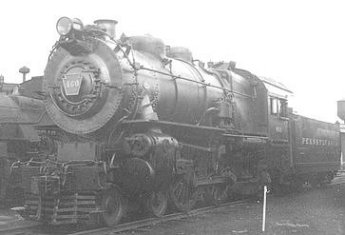 No. 460 at Northumberland PA on 18/5/65. Photo by Bill Volmer from the Don Ross collection
No. 460 at Northumberland PA on 18/5/65. Photo by Bill Volmer from the Don Ross collection
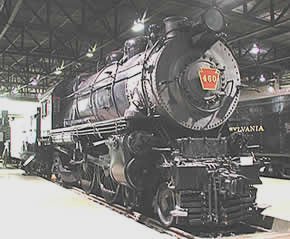
Photo of No. 460 today, with thanks to the Railroad Museum of Pennsylvania |
|
The 100 ton train ran the 216 miles behind No. 460 in 175 minutes, an average of 74 mph inclusive of stops and other slowings. The run led to claims that over 100 mph was reached several times, with a maximum of 115 mph. But how were these speeds calculated? It is the dispatchers' times that remain from that run: railway staff at stations and signal boxes who telegraphed the train's passing time to a central point using their local clocks. That leaves two very large areas of doubt. Were the clocks all synchronised exactly? And were the methods used to take the times at each point the same? Highly unlikely in both cases, even though efforts were made to keep all clocks at the same time throughout the line. Over very long distances errors within that system of time recording are small when translated into average speeds. But over short distances even an error of a few seconds can give a large variation in average speed. In this page and the next I have shown all of the dispatcher's times and the average speeds that are calculated for the distances between those times, (light panels in the tables). Significant variations in average speeds are apparent. |
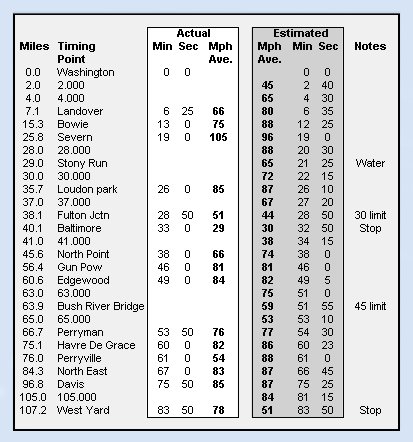 | |||
| Next to the actual times and speeds, for illustrative purposes, I have used a computer spreadsheet to view the run as it could have happened, (dark panel). With smoother accelerations and slowings, and without wild swings in average speeds unless influenced by known speed restrictions or stops. This is done without the benefit of a gradient profile and without full knowledge of the route. So they are rough and ready calculations only, and should be viewed as such. See how the fluctuations in speeds from the dispatchers times, (Severn and Perryville), are removed when my estimates are used. More so below. | ||||
|
To the right is the second half of the run. On both parts of the run I have added extra timing points on the computer spreadsheet to help calculate smoother accelerations and slowings, but the times to look at are my estimates at the same places where dispatchers times are shown. Many of my times are the same, at the most they vary by only 40 seconds. Yet some of the average speeds change dramatically. Ignore the 144 mph dispatcher average speed at Lamokin Street: that is just a product of what can happen with approximate times and exact distances. But look at the wild variations in speed arising from the dispatchers times from SV Tower, (signal box) onwards. A 108 mph average, then 57 mph! Followed by 76 mph and then the claimed 114 mph, (115 mph), followed by 84 mph and more variations. Steam locomotives don't run like that, and on this run it is fair to assume a consistent high speed was maintained wherever possible. My estimated times next to these dispatcher times and average speeds give a far more consistent and possible record of the progress of the train. With the fastest average being under 90 mph over the stretch from SV Tower. Did Pennsy' RR E6s No. 460 reach or exceed 100 mph? |
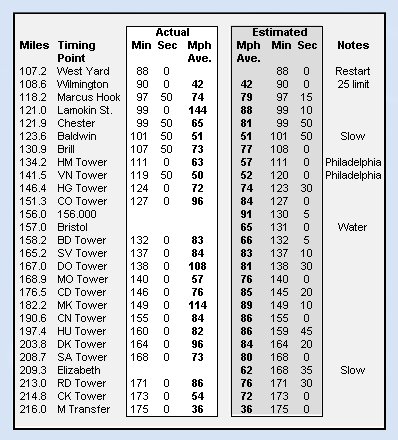
| |||
| My rough estimates give a 96 mph average from Bowie to Severn, a 10.5 mph stretch, easily long enough to include a 100 mph maximum. But my estimates are just that, estimates. Not enough to say with certainty that 100 mph was reached, even though the loco had the capability and opportunity to do so. With more route knowledge and a detailed gradient profile I can refine my estimates, but maybe not to the extent needed to prove that 100 mph was certainly reached on the Lindbergh run. | ||||
| Credits I have drawn on what many have said & published, including Steve Palmano, Jim Scribbings, (Apex Of The Atlantics) and Leo Sullivan | ||||
|
Milwaukee Rail Road F6 Hudson number 6402, (later number 127) |
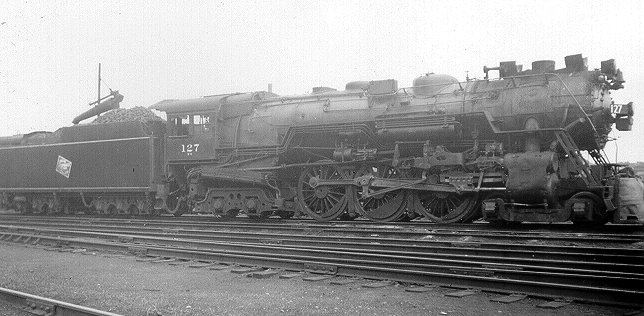
CMStP and P no. 127, (formerly no. 6402) at Milwaukee, WI., 1 July 1950. Photo thanks to the Don Ross Collection |
| The Milwaukee Rail Road F6 Hudsons | ||||
| Built | BALDWIN in 1930 | Total weight incl tender | 266 imp. tons | |
| Number Built | 14 locos nos 6400 to 6413 | Fuel | Coal, (mechanical stoker) | |
| Withdrawn, (all scrapped) | 1952 - 1954 | Fire grate area | 80 sq feet | |
| Cylinders | 2 sized 26" x 28" | Max i.hp | To follow | |
| Driving Wheels | 79" diameter | Boiler Pressure | 225 psi | |
|
Background
For vistors to this site who have read about the Milwaukee Road A class Atlantics and F7 Hudsons on the World's Fastest Steam Loco page of this site it will be no surprise to see a Milwaukee Road steam loco as a candidate for the title of "The First Steam Loco to Reach 100 mph". The photo reproduced with permission from that outstanding Kalmbach Publishing Co. book, "The Hiawatha Story" by Jim Scribbings shows Milwaukee Road F6 Hudson #6402 very soon after arrival at Milwaukee from Chicago on July 20th 1934. |
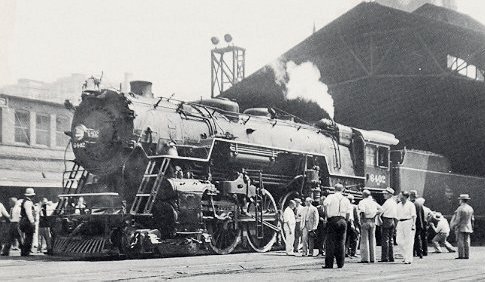 MRR F6 Hudson #6402 at Milwaukee after it's historic July 20th 1934 run from Chicago.
MRR F6 Hudson #6402 at Milwaukee after it's historic July 20th 1934 run from Chicago.
Photo by Milwaukee Road, from "The Hiawatha Story" by Jim Scribbings, copyright 1970, Kalmbach Publishing Co. Used with permission. |
|
What are the facts concerning this high speed journey? On that day hauling a normal service train, (train, 29 redesignated as Second 27 just for that day), the loco was on a special timing to Milwaukee to prove the feasibility of a high speed service. The run was an outstanding success and was directly responsible for the introduction less than a year later of what were to become the fastest scheduled steam hauled train services the world has ever seen, "The Hiawathas". So what happened on July 20th 1934 that not only set up the road for the Hiawathas, but also put #6402 as a contender for the first steam loco to reach an authentic 100 mph? Well, that 4-6-4 with a load of 375 imperial tons behind the tender, ran the 85 miles from Chicago to Milwaukee in 67 minutes and 35 seconds start to stop. Way inside the eventual Hiawatha schedule of 75 minutes that regularly saw running over 100 mph. | |
| The #6402 run on July 20th 1934 had a slow start and finish. In between it ran the 68.74 miles between Mayfair and Lake in 45 minutes and 53 seconds, an average pass to pass speed of 89.89 mph. Times were at each station to the nearest second, and the loco recording speedometer chart showed a max of 103.5 mph. But did the detailed station times support that maximum? The most important of those was the 3 minutes and 12 seconds for the 5.1 miles between Oakwood and Lake. An average of 95.6 mph. This time was reported by the late Brian Reed in his booklet, "Loco profile 26, The Hiawathas". Looking further into that booklet there is a short section of a speed recorder roll from a later run by an A class Atlantic. Onto that reproduced speedroll someone has written the gradient. It starts at 1/386 downhill through Oakwood, and then becomes a 1/185 - 1/154 uphill through Lake. For a significant part of the time 6402 was averaging 95.6 mph it was climbing steeply on a grade where speed must have fallen off quickly. In all probability the maximum would have been at the bottom of the grade through Oakwood, which was at a point just over half way between Oakwood and Lake. I have experimented with a computer spreadsheet model for this distance to try and estimate what could have happened. The "best fit" for me is that #6402 passed Oakwood in the low 90s, and on the steep climb through Lake was running in the high 80s. That model suggests a maximum speed of at least 101 mph at bottom of the dip, just as the 1/185 up grade started. But my estimates are just that. No other data is available to me.
And what did renowned steam loco expert Brian Reed who mentioned some of the timing data in his Loco Profile say about this run? I quote his words..."This was the first North American high-speed steam run to have timing and running data sufficient to support most of the speeds claimed...........This must be taken as the first time a U.S. steam loco topped "the hundred"..... |
| Did #6402 reach 100 mph?
In all probability Milwaukee Road 4-6-4 #6402 slightly exceeded 100 mph on July 20th 1934. The words and research of Brian Reed and my own instinct and experience as a long time timer of steam locos draw me to that conclusion. Thus making #6402 the first steam loco to reach an authentic "ton". But neither the full timing log or any other details remain available for myself and my peers to delve into to give this conclusion 100% documentary support. So my research will continue to see when the first totally substantiated steam 100 mph happened, ( with detailed and still available passing times). But there is no doubt that when my final conclusions are documented #6402 will feature in them. Such a run as on 20th July 1934 cannot be ignored. |
|
Credits I have drawn on what many have said & published, including Kalmbach Publishing Co, Steve Palmano, Brian Reed, (Loco Profile 26) and Jim Scribbings, (Hiawatha Story).
|
| LNER A1 pacific No. 4472 |
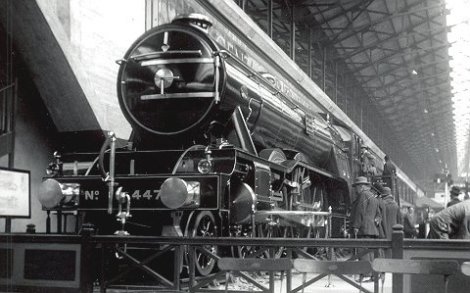 Photo is part of a photograph from the Ken Nunn collection thanks to the Locomotive Club of Great Britain; 4472 is seen at the British Empire Exhibition, Wembley on 10th October 1925. |
| The LNER A1 pacifics | ||||
| Built | LNER from 1922, (A1) | Total weight EXCL tender | 96 tons | |
| Number Built | To Follow | Fuel | Coal | |
| Withdrawn, (all scrapped except 4472) | 1959 - 1966 | Fire grate area | 41.25 sq feet | |
| Cylinders | 3, sized 20" x 26" | Max i.hp | To follow | |
| Driving Wheels | 80" diameter | Boiler Pressure | 180 psi | |
|
Background Between 1935 and 1939 the LNER set standards of scheduled high speed steam operation that were never equalled in the UK. Those speeds were not on a par with those achieved in the USA by the A class Atlantics and F7 Hudsons on the Hiawathas during the same years, but there is a lot of similarity in the origins of both the LNER high speed trains and the Hiawathas. One similarity was the use of a less powerful and non streamlined steam loco to test the feasability of operating daily high speed passenger train services. So the run by LNER A1 pacific 4472, "Flying Scotsman" on 30th November 1934 was a mirror of Milwaukee Road's #6402 run on 20th July of the same year. Both trains ran faster than any other steam locomotive had ever run before over long distances and both reached a maximum speed that made them claimants for the title of the first steam loco to run at 100 mph. Indeed, for many years before I started research into this subject I was convinced that the claimed 100 mph by 4472 on November 30th 1934 was the first fully documented 100 mph by a steam locomotive. But was it? What are the facts concerning this high speed journey? With just a four coach train and with famed driver William Sparshatt at the controls 4472 ran the 185.8 miles from London's Kings Cross to Leeds in 151 minutes and six seconds. For the return journey the load was increased to 6 coaches, and it was on the descent of Stoke Bank, between Little Bytham and Essendine that the dynamometer car recorded a momentary 100 mph. That claim remained largely undisturbed, (although not by O.S.Nock in his book "Speed Records on Britains Railways", David and Charles 1971), until a STEAM RAILWAY magazine article, (SR286 in 2003), published evidence that to me and other exponents of timing steam locomotive performance completely undermined the 100 mph claim. |
|
Two key facts come from the STEAM RAILWAY magazine article. First were comments in his 1971 book by railway author O.S.Nock, himself an expert train timer, on C.J Allen's timings, (C.J was onboard with his stopwatch that day) ......"C.J.Allen clocked two alternative quarter mile speeds of 97.3 mph, whereas the dynamometer car chart showed a marked but rather unnatural peak of exactly 100mph. Allen himself...quoted 98 mph in his log."
The second fact was the reproduction in STEAM RAILWAY magazine of the dynamometer car chart over the stretch where the claimed 100 mph was reached. This shows a steady and slow build up of speed through the 90s, as one would expect. Then a sudden "jump" in the chart to 100 mph and a "jump" back down again to a speed in the 90s. As if the recording pen had been jolted. Indeed it had to have been moved by a force other than the speed of the train because the sudden acceleration represented by the chart would be impossible. Putting the sight of that reproduced chart and the comments of O.S.Nock re C.J.Allens timings together leaves no doubt in my mind that 4472 reached 98 mph as a maximum and no more. Even though the above invalidates the 100 mph claim I have taken the matter further by modelling the descent between Little Bytham and Essendine, where the 100 mph was claimed, on a computer spreadsheet. Taking into account the grades I have assumed the maximum would have been just below Little Bytham which was passed at 95.5 mph. It is just below Little Bytham that the 1/200 downhill grade ends and is where the STEAM RAILWAY magazine reproduced dynamometer car chart shows the claimed 100 mph. It is unrealistic to assume the pacific could have accelerated up to 100 mph on the subsequent easier grades including some level and some slightly uphill track. From my calculations it is likely that 4472 would have needed to have travelled between Little Bytham and Essendine approaching 2 seconds faster than the 2 minutes 13 seconds recorded by C.J.Allen to have attained 100 mph. The time of 2 mins and 13 seconds supports a maximum of around 98 mph. | ||||
|
Did 4472 reach 100 mph? 4472 ran superbly on 30th November 1934, averaging high speeds and setting journey times never before seen in the UK. But 4472, "Flying Scotsman" did not reach 100 mph on that day. Her maximum speed was 98 mph, as recorded and reported by C.J Allen at the time, and as subsequently "endorsed" by O.S.Nock. Two gentlemen who were among the most respected steam locomotive performance experts in railway history. | ||||
|
Credits I have drawn on what many have said & published, including Jonathan Glancey and STEAM RAILWAY magazine.
| ||||
| LNER A3 pacific No. 2750 |
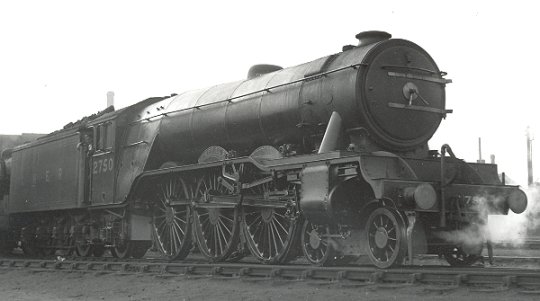 Photo is part of a photograph from the Ken Nunn collection with thanks to the Locomotive Club of Great Britain; 2750 is on shed at Kings Cross on 28th September 1935.
Photo is part of a photograph from the Ken Nunn collection with thanks to the Locomotive Club of Great Britain; 2750 is on shed at Kings Cross on 28th September 1935.
|
| The LNER A3 pacifics | ||||
| Built | To Follow | Total weight EXCL tender | 96 tons | |
| Number Built | To Follow | Fuel | Coal | |
| Withdrawn, (all scrapped except 4472) | 1959 - 1966 | Fire grate area | 41.25 sq feet | |
| Cylinders | 3, sized 19" x 26" | Max i.hp | To follow | |
| Driving Wheels | 80" diameter | Boiler Pressure | 220 psi | |
|
Background The high speed testing on the LNER was not ended with the 30th November 1934 run by 4472. In March 1935 a further test run was made which preceeded the introduction of the "Silver Jubilee". As in the previous November it was an LNER pacific that was to head the 6 car train: but a more powerful loco than 4472 in the guise of an A3. The route was London, Kings Cross to Newcastle and return, and the driver was again William Sparshatt. What are the facts concerning this high speed journey? For the first time in this research into the first steam loco to reach 100 mph the facts are clear, straightforward and undisputable! In the single day of 5th March 1935 the A3 pacific with a 6 car train weighing 217 tons gross covered 500 miles in 423 minutes and 23 seconds, an average speed of 72.7 mph. That included all normal speed restrictions plus ten and a half minutes of out of course checks. 300 miles of the days running was completed at an average of 80 mph. On the return journey, on the descent of Stoke Bank, 2750 Papyrus passed Little Bytham at 106 mph, reached a maximum of 108 mph soon afterwards and was still travelling at 102 mph through Essendine. The times taken by C. J. Allen give an average over the fastest stretch of 100.6 mph for 12.25 miles. Between Little Bytham and Essendine the 3.6 miles were covered in 2 minutes and 3 seconds: an average speed of 105.3 mph. So for the first time anywhere in the world full documentation was taken, and preserved, of sufficient timing details to demonstrate that without a shadow of doubt a steam locomotive had reached 100 mph. Sadly, and with all the confusion and irregularities over the previous claims for UK steam locomotives to have reached this benchmark speed, (i.e City of Truro and Flying Scotsman), 2750 was scrapped after being withdrawn from service as the end of steam in the UK approached. Did 2750 "Papyrus" reach 100 mph on 5th March 1935? Yes! Without any possibility of doubt. But read my concluding words on the whole matter of the first steam locomotive to reach 100 mph, by following the link below. |
|
Credits I have drawn on what many have said & published, including Jonathan Glancey.
|
|
You've read about the first 100 mph steam loco. Now read about the first steam loco to get to the magic three figures in the 21st Century! |
| Ex DR pacific 18 201 |
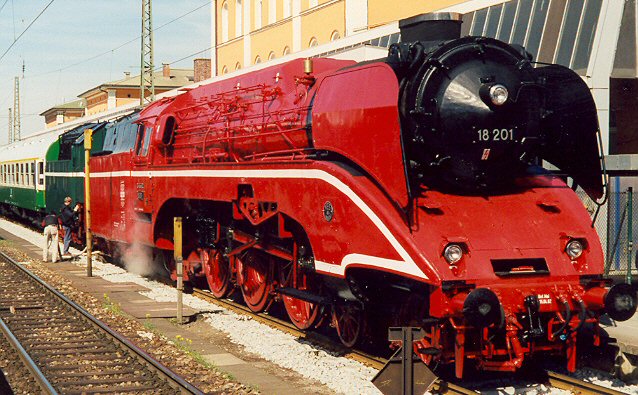 Just ex-works on May 1st 2002, ex DR pacific 18 201 is seen at Passau while operating a Nürnberg to Wien Special Train.
Just ex-works on May 1st 2002, ex DR pacific 18 201 is seen at Passau while operating a Nürnberg to Wien Special Train.
|
| Built | 1939 & 196, (rebuilt) | Total weight EXCL tender | To Follow | |
| Number Built | 1 | Fuel | Oil | |
| Withdrawn | Still in service | Fire grate area | To follow | |
| Cylinders | 3 | Max i.hp | To follow | |
| Driving Wheels | 90" diameter | Boiler Pressure | to follow |
|
This web page has examined the evidence for the first steam loco 100 mph. Once that speed was reached it set a bench mark for the fastest steam running: record attempts excepted. 100 mph was regularly reached from the late 1930s, into the 1940s, (USA), and from the 1950s in the 1960s. The last country to see 100 mph steam running, (unofficially), was in the UK by SR Bulleid pacifics: ending on 10th July 1967 when steam was withdrawn. To train timers that ended the chance of 100 mph steam operation. Even when the UK ban on using preserved steam locos on main lines was lifted in the 1970s, and then in other parts of Europe, it never seemed steam would be allowed to run at anything close to 100 mph. But that hadn't counted on Ex Deutsche Reichsbahn pacific 18 201! A loco built in 1939 as high speed 4-6-6 tank loco 61.002 for a fast Berlin to Dresden service, and rebuilt in 1961 for use testing fast rolling stock being built by Eastern block countries for export. |
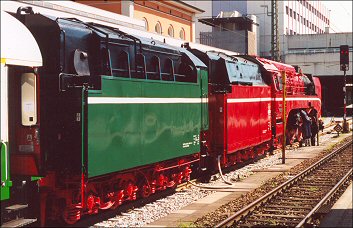 18 201 at Passau on May 1st on the journey from Nurnberg to Wien. The green second tender is the loco's normal colour
18 201 at Passau on May 1st on the journey from Nurnberg to Wien. The green second tender is the loco's normal colour | |
|
In 1987 the loco hauled a British enthusiast chartered train in Austria. Reports are conflicting, but it seems the pacific got very close to, or maybe just touched 100 mph near to St Egyden on the descent from Gloggnitz to Wiener Neustadt. After the Berlin Wall came down it joined the DB Museum fleet but was soon out of service until Dampf-Plus put the big Pacific, on loan from DB Museum, back into service in 2002. It didn't take long after leaving Meiningen Loco Works in April 2002 for the loco to run fast: reported as into the 90s on an early public test run, but with no detailed records made! It did have a design top speed of 180 km/h after all, (112.5 mph). I missed the test run but was interested in it's first planned long distance journey after overhaul, from Nürnberg to Wien on 1st May, followed by a poorly advertised Schnellfahrt from Wien on May 5th. And so it was that on Sunday May 5th, after a good trip out from Nürnberg to Wien behind the now red pacific on May 1st, my wife Bobbie and myself boarded the first of two return trips to Gloggnitz at Wien Sudbanhof. Joined by fellow UK train timer John Barnes and his young son Paul: the low level advertising meaning no one else from the UK joined us. A fast run to Wiener Neustadt saw the loco then turned to haul us to Gloggnitz for the first of the two "schnellfahrten" back to Wien. Next to us at Gloggnitz was an electric loco hauled train that would run parallel to near Wiener Neustadt to film the big pacific at speed. | ||
|
Bobbie and I were in a corridor by an empty compartment at the rear of the 7 car train to avoid the short parallel train blocking our view when it ran alongside 18 201. There must have been a good chance of reaching 100 mph on that first run, but for a badly posted temporary speed restriction, (tsr), in the loop at Neunkirchen on the side used by the parallel train, (the arrow pointing to the loop had fallen off). So our rapid acceleration from 93 at Neunkirchen to 96 mph was checked to allow the other train, (which had slowed for the tsr), to catch up. Back at Wien we checked GPS readings against stopwatch speeds, before returning to Gloggnitz behind 18 201 for the second fast run. The pacific ran round our train and waited next to the Electric loco on the parallel train where a video camera was being set up. That lost our 16.25 slot, leaving instead at 16.50. Rain eased as both trains left Gloggnitz, but in my mind still was the badly posted tsr at Neunkirchen and if it would again slow the parallel train, and therefore us. But no, both trains raced through Neunkirchen in the 90s, and at around 96 mph I went though the empty compartment to the "close side" to see the km posts as the parallel train dropped behind us, blocking my view on the "open side". | ||
|
The excitement had grown in Bobbie's voice passing 96 mph, "96.9, 98.2, 99.7" she called out as I stuck to my stopwatching, and as I realised the parallel train had fallen behind I rushed back to her side where I had a clearer view of the km posts across the now empty second track. "99.9" she shouted at a point where I didn't take a time. Without brakes coming on I realised we were still accelerating and shouted back "we're doing a hundred", at which point, her eyes fixed rigid on the GPS handset, she replied "100" and then, "101". Despite her rigid focus on the GPS her voice couldn't hide the excitement she obviously felt for me. We raced through St Egyden where a lucky group photographed a steam loco travelling at over 100 mph! I stopwatched km posts 800 metres apart as Bobbie shouted "101" for the third time as we passed the second post, just as the brakes came on. I expected a rapid deceleration and looked quickly at the GPS so I could see still it showing 100 mph, realising then with a 3 figure read out why no decimal points over 100 mph had been called. All too soon that hectic period of activity came to an end as we stopped at Wiener Neustadt where John Barnes and I made our first quick calculations, agreeing the maximum as 102 mph. The GPS being maybe a fraction under that, but without decimal points over 100 mph unable to give the exact speed. And then onto Wien Sudbahnhof where I let Klaus Bechstedt, our driver, know that he had just made railway history with the first Steam "100" of the 21st Century. |
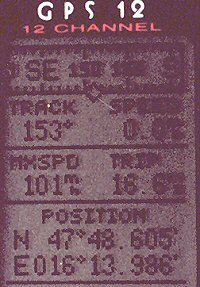 The GPS keeps the maximum speed on display until cancelled: allowing me to photo the 101 mph readout
The GPS keeps the maximum speed on display until cancelled: allowing me to photo the 101 mph readout
| |
| The Original Timing Log of 5th May 2002 | ||
| Right is a copy of my note book pages starting part way down the left side with the departure time from Gloggnitz. Subsequent times are the exact journey times from my digital stopwatch, ending at Wiener Neustadt, 15 mins 10.16 secs later. Intermediate station times are taken to the nearest second, unless a km post on the platform was stopwatched, (not here), and the names put in when compiling the spreadsheet. The tick next to km distances is my shorthand for ground based Km posts. A cross or the exact metre distance shows the electrification mast plates used. Those without a mark are by default electrification mast plates, as in most of my timing on electrified routes I do mark old style ground posts. On electrified routes I write down the exact metre distances from each mast plate when I take the stopwatch reading. In this case I didn't for many km mast plates as I had already noted them before 5th May.
|
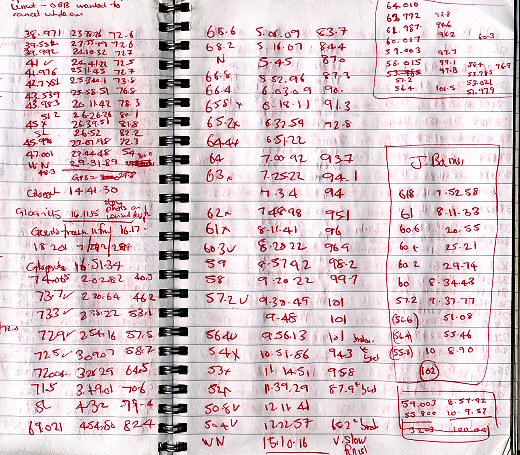 | |
|
The speeds written next to my stopwatch times are those Bobbie shouted out from the GPS handset. Watching me carefully she tried to shout a speed just after I had taken each time. A consistent basis that allows for good subsequent comparisons. Times at Km mast plates 59 and 58 were taken on the other side of the train as we passed the chasing train.
| ||
|
I had difficulty reading these km plates so close to the train, so took times at the whole numbers as I had their exact distances from before 5th May. The top of the three boxes on the right of my note book shows my initial speed calculations in Wiener Neustadt using exact distances. This was when I realised I had timed 101.5 mph over 800 metres! The second box shows John Barne's times over the fast part: the gap between Km 60 and Km 57.2 was because he didn't swap sides when we overhauled the other train. He was ahead of me in the train, hence his times are also ahead of mine. In a circle is the 102 mph he clocked. | ||
| The lower box was a calculation I made over a longer distance with the fastest part, giving me confidence in my maximum speed. Using John Barnes figures as well as my own shows we averaged 100 mph over 3,203 metres (1.99 Miles), starting at just over 98 mph,then up to 102 mph and under braking at the end of that stretch down to below 100 mph. Good confirmation of our 102 mph. It was very fortunate I had got the GPS unit for Bobbie to use just a few days before this trip, and that John Barnes had joined us on this train. It meant I was subsequently able to produce a very detailed time analysis of a steam locomotive 100 mph, (next page). All previous steam "tons" being before GPS units came into use, all but one (and that disputed), before digital stopwatches, and all those from dynamometer cars in the distant past relying on a moving pen over a chart. A system now regarded as not always accurate.
|  | |
| In the spreadsheet, (next page), I have for illustrative purposes only, included two of John Barnes times within mine. My figures on their own show a max of 101.5 mph over 800 metres, supporting the 102 mph maximum over a short distance within that 800 metres stretch. John's have been added to show the short distance within that 800 metre stretch where he timed the maximum speed of 102.1 mph. An alternative would have been to show his log in addition to mine, but the result would still be the same: a maximum speed of 102 mph.
|
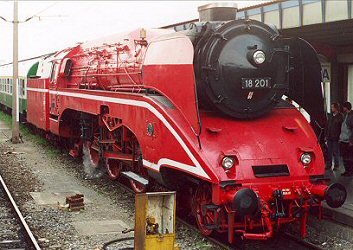 At Wien Sudbahnhof just over an hour after reaching 102 mph
At Wien Sudbahnhof just over an hour after reaching 102 mph
| |
| The Detailed Computerised Timing Log of 5th May 2002 |
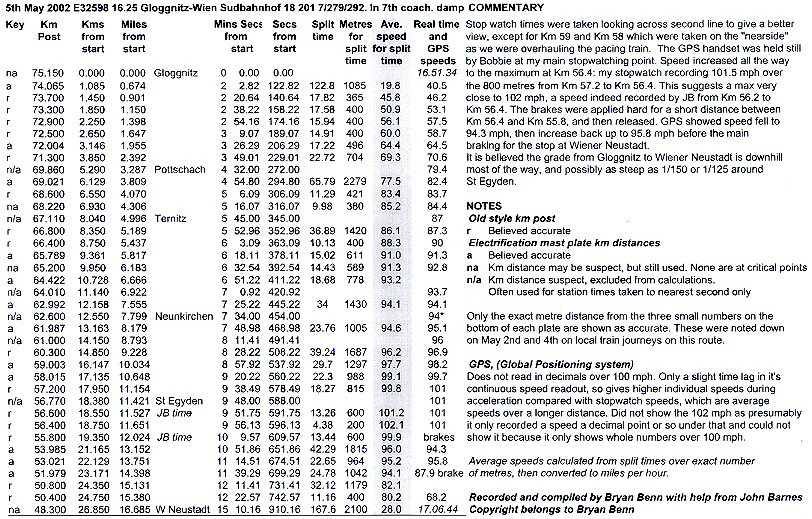
|
| CREDITS
|
| Many people have helped in providing photographs and other information to me. Sometimes unknowingly helped me by what they have previously said, written or had published.
It is my intention to list those who have helped at the end of the relevant locomotive section as each one is completed. But please note that those who have helped me do not necessarily agree with everything I have written or with any statements I make or conclusions I come to. So if you don't agree with any of the content of this web page please contact me with your views, and do not criticise those who have been kind enough to help, or have in some other way been a source of information. |
| Bryan Benn
|
|
| |
|
| |